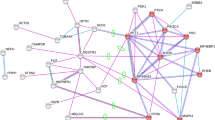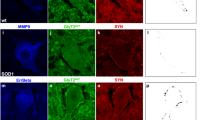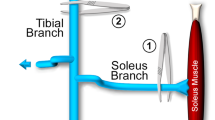Abstract
Neurodegenerative diseases can have long preclinical phases and insidious progression patterns, but the mechanisms of disease progression are poorly understood. Because quantitative accounts of neuronal circuitry affected by disease have been lacking, it has remained unclear whether disease progression reflects processes of stochastic loss or temporally defined selective vulnerabilities of distinct synapses or axons. Here we derive a quantitative topographic map of muscle innervation in the hindlimb. We show that in two mouse models of motoneuron disease (G93A SOD1 and G85R SOD1), axons of fast-fatiguable motoneurons are affected synchronously, long before symptoms appear. Fast-fatigue-resistant motoneuron axons are affected at symptom-onset, whereas axons of slow motoneurons are resistant. Axonal vulnerability leads to synaptic vesicle stalling and accumulation of BC12a1-a, an anti-apoptotic protein. It is alleviated by ciliary neurotrophic factor and triggers proteasome-dependent pruning of peripheral axon branches. Thus, motoneuron disease involves predictable, selective vulnerability patterns by physiological subtypes of axons, episodes of abrupt pruning in the target region and compensation by resistant axons.
This is a preview of subscription content, access via your institution
Access options
Subscribe to this journal
Receive 12 print issues and online access
$209.00 per year
only $17.42 per issue
Buy this article
- Purchase on Springer Link
- Instant access to full article PDF
Prices may be subject to local taxes which are calculated during checkout








Similar content being viewed by others
References
Coleman, P.D. & Yao, P.J. Synaptic slaughter in Alzheimer's disease. Neurobiol. Aging 24, 1023–1027 (2003).
Gurney, M.E. et al. Motor neuron degeneration in mice that express a human Cu,Zn superoxide dismutase mutation. Science 264, 1772–1775 (1994).
Bruijn, L.I., Miller, T.M. & Cleveland, D.W. Unraveling the mechanisms involved in motor neuron degeneration in ALS. Annu. Rev. Neurosci. 27, 723–749 (2004).
Frey, D. et al. Early and selective loss of neuromuscular synapse subtypes with low sprouting competence in motoneuron diseases. J. Neurosci. 20, 2534–2542 (2000).
Fischer, L.R. et al. Amyotrophic lateral sclerosis is a distal axonopathy: evidence in mice and man. Exp. Neurol. 185, 232–240 (2004).
Lino, M.M., Schneider, C. & Caroni, P. Accumulation of SOD1 mutants in postnatal motoneurons does not cause motoneuron pathology or motoneuron disease. J. Neurosci. 22, 4825–4832 (2002).
Clement, A.M. et al. Wild-type nonneuronal cells extend survival of SOD1 mutant motor neurons in ALS mice. Science 302, 113–117 (2003).
Liu, J. et al. Toxicity of familial ALS-linked SOD1 mutants from selective recruitment to spinal mitochondria. Neuron 43, 5–17 (2004).
Pasinelli, P. et al. Amyotrophic lateral sclerosis-associated SOD1 mutant proteins bind and aggregate with Bcl-2 in spinal cord mitochondria. Neuron 43, 19–30 (2004).
Wong, P.C. et al. An adverse property of a familial ALS-linked SOD1 mutation causes motoneuron disease characterized by vacuolar degeneration of mitochondria. Neuron 14, 1105–1116 (1995).
Collard, J.F., Cote, F. & Julien, J.P. Defective axonal transport in a transgenic mouse model of amyotrophic lateral sclerosis. Nature 375, 61–64 (1995).
Zhang, B., Tu, P., Abtahian, F., Trojanowski, J.Q. & Lee, V.M. Neurofilaments and orthograde transport are reduced in ventral root axons of transgenic mice that express human SOD1 with a G93A mutation. J. Cell Biol. 139, 1307–1315 (1997).
Williamson, T.L. & Cleveland, D.W. Slowing of axonal transport is a very early event in the toxicity of ALS-linked SOD1 mutants to motor neurons. Nat. Neurosci. 2, 50–56 (1999).
Pinter, M.J., Waldeck, R.F., Wallace, N. & Crok, L.C. Motor unit behavior in canine motor neuron disease. J. Neurosci. 15, 3447–3457 (1995).
Kostic, V., Jackson-Lewis, V., de Bilbao, F., Dubois-Dauphin, M. & Przedborski, S. Bcl-2: prolonging life in a transgenic mouse model of familial amyotrophic lateral sclerosis. Science 277, 559–562 (1997).
Sagot, Y. et al. Bcl-2 overexpression prevents motoneuron cell body loss but not axonal degeneration in a mouse model of a neurodegenerative disease. J. Neurosci. 15, 7727–7733 (1995).
Lobsiger, C.S., Garcia, M.L., Ward, C.M. & Cleveland, D.W. Altered axonal architecture by removal of the heavily phosphorylated neurofilament tail domains strongly slows superoxide dismutase 1 mutant-mediated ALS. Proc. Natl. Acad. Sci. USA 102, 10351–10356 (2005).
Sagot, Y., Rosse, T., Vejsada, R., Perrelet, D. & Kato, A.C. Differential effects of neurotrophic factors on motoneuron retrograde labeling in a murine model of motoneuron disease. J. Neurosci. 18, 1132–1141 (1998).
Burke, R.E. Physiology of motor units. in Myology (eds. Engel, A.G. & Franzini-Armstrong, C.) 464–484 (McGraw-Hill, New York, 1994).
De Paola, V., Arber, S. & Caroni, P. AMPA receptors regulate dynamic equilibrium of presynaptic terminals in mature hippocampal networks. Nat. Neurosci. 6, 491–500 (2003).
Stokin, G.B. et al. Axonopathy and transport deficits early in the pathogenesis of Alzheimer's disease. Science 307, 1282–1288 (2005).
Gunawardena, S. & Goldstein, L.S. Polyglutamine diseases and transport problems: deadly traffic jams on neuronal highways. Arch. Neurol. 62, 46–51 (2005).
Nguyen, Q.T., Sanes, J.R. & Lichtman, J.W. Pre-existing pathways promote precise projection patterns. Nat. Neurosci. 5, 861–867 (2002).
Watts, R.J., Hoopfer, E.D. & Luo, L. Axon pruning during Drosophila metamorphosis: evidence for local degeneration and requirement of the ubiquitin-proteasome system. Neuron 38, 871–885 (2003).
Zhai, Q. et al. Involvement of the ubiquitin-proteasome system in the early stages of Wallerian degeneration. Neuron 39, 217–225 (2003).
Raff, M.C., Whitmore, A.V. & Finn, J.T. Axonal self-destruction and neurodegeneration. Science 296, 868–871 (2002).
Bruijn, L.I. et al. ALS-linked SOD1 mutant G85R mediates damage to astrocytes and promotes rapidly progressive disease with SOD1-containing inclusions. Neuron 18, 327–338 (1997).
Bommel, H. et al. Missense mutation in the tubulin-specific chaperone E (Tbce) gene in the mouse mutant progressive motor neuronopathy, a model of human motoneuron disease. J. Cell Biol. 159, 563–569 (2002).
Williamson, T.L. et al. Absence of neurofilaments reduces the selective vulnerability of motor neurons and slows disease caused by a familial amyotrophic lateral sclerosis-linked superoxide dismutase 1 mutant. Proc. Natl. Acad. Sci. USA 95, 9631–9636 (1998).
Couillard-Despres, S. et al. Protective effect of neurofilament heavy gene overexpression in motor neuron disease induced by mutant superoxide dismutase. Proc. Natl. Acad. Sci. USA 95, 9626–9630 (1998).
Peterson, W.M., Wang, Q., Tzekova, R. & Wiegand, S.J. Ciliary neurotrophic factor and stress stimuli activate the Jak-STAT pathway in retinal neurons and glia. J. Neurosci. 20, 4081–4090 (2000).
Park, K., Luo, J.M., Hisheh, S., Harvey, A.R. & Cui, Q. Cellular mechanisms associated with spontaneous and ciliary neurotrophic factor-cAMP-induced survival and axonal regeneration of adult retinal ganglion cells. J. Neurosci. 24, 10806–10815 (2004).
Lee, H.H., Dadgostar, H., Cheng, Q., Shu, J. & Cheng, G. NF-kappaB-mediated up-regulation of Bcl-x and Bfl-1/A1 is required for CD40 survival signaling in B lymphocytes. Proc. Natl. Acad. Sci. USA 96, 9136–9141 (1999).
Delio, D.A., Fiori, M.G. & Lowndes, H.E. Motor unit function during evolution of proximal axon swellings. J. Neurol. Sci. 109, 30–40 (1992).
LaMonte, B.H. et al. Disruption of dynein/dynactin inhibits axonal transport in motor neurons causing late-onset progressive degeneration. Neuron 34, 715–727 (2002).
Xia, C.H. et al. Abnormal neurofilament transport caused by targeted disruption of neuronal kinesin heavy chain KIF5A. J. Cell Biol. 161, 55–66 (2003).
Al-Chalabi, A. et al. Ciliary neurotrophic factor genotype does not influence clinical phenotype in amyotrophic lateral sclerosis. Ann. Neurol. 54, 130–134 (2003).
Giess, R. et al. Early onset of severe familial amyotrophic lateral sclerosis with a SOD-1 mutation: potential impact of CNTF as a candidate modifier gene. Am. J. Hum. Genet. 70, 1277–1286 (2002).
Schaefer, A.M., Sanes, J.R. & Lichtman, J.W. A compensatory subpopulation of motor neurons in a mouse model of amyotrophic lateral sclerosis. J. Comp. Neurol. 490, 209–219 (2005).
Atkin, J.D. et al. Properties of slow- and fast-twitch muscle fibres in a mouse model of amyotrophic lateral sclerosis. Neuromuscul. Disord. 15, 377–388 (2005).
Raoul, C, (2002) Motoneuron death triggered by a specific pathway downstream of Fas: potentiation by ALS-linked SOD1 mutations. Neuron 35, 1067–1083 (2002).
Dengler, R. et al. Amyotrophic lateral sclerosis: macro-EMG and twitch forces of single motor units. Muscle Nerve 13, 545–550 (1990).
Larsson, L., Li, X., Tollback, A. & Grimby, L. Contractile properties in single muscle fibers from chronically overused motor units in relation to motoneuron firing properties in prior polio patients. J. Neurol. Sci. 132, 182–192 (1995).
Nguyen, M.D., Lariviere, R.C. & Julien, J.P. Reduction of axonal caliber does not alleviate motor neuron disease caused by mutant superoxide dismutase 1. Proc. Natl. Acad. Sci. USA 97, 12306–12311 (2000).
Shaw, P.J. & Eggett, C.J. Molecular factors underlying selective vulnerability of motor neurons to neurodegeneration in amyotrophic lateral sclerosis. J. Neurol. 247, I17–I27 (2000).
von Lewinski, F. & Keller, B.U. Ca2+, mitochondria and selective motoneuron vulnerability: implications for ALS. Trends Neurosci. 28, 494–500 (2005).
Kuo, J.J. et al. Hyperexcitability of cultured spinal motoneurons from presymptomatic ALS mice. J. Neurophysiol. 91, 571–575 (2004).
Gunawardena, S. & Goldstein, L.S. Disruption of axonal transport and neuronal viability by amyloid precursor protein mutations in Drosophila. Neuron 32, 389–401 (2001).
Gunawardena, S. et al. Disruption of axonal transport by loss of huntingtin or expression of pathogenic polyQ proteins in Drosophila. Neuron 40, 25–40 (2003).
Mittoux, V. et al. Restoration of cognitive and motor functions by ciliary neurotrophic factor in a primate model of Huntington's disease. Hum. Gene Ther. 11, 1177–1187 (2000).
Acknowledgements
We are grateful to C. Schneider (Friedrich Miescher Institut) for technical assistance, S. Lefler (Friedrich Miescher Institut) for myosin heavy chain (MHC) labeling data, M.T. Carri (University of Rome, Tor Vergata, Italy) for sharing with us their results on Bc12a1-a induction in FALS and S. Arber (Friedrich Miescher Institut and Biozentrum, University of Basel) for comments on the manuscript. S.S. was supported by EU FP6 (NeuroNE). The Friedrich Miescher Institut is part of the Novartis Research Foundation.
Author information
Authors and Affiliations
Corresponding author
Ethics declarations
Competing interests
The authors declare no competing financial interests.
Rights and permissions
About this article
Cite this article
Pun, S., Santos, A., Saxena, S. et al. Selective vulnerability and pruning of phasic motoneuron axons in motoneuron disease alleviated by CNTF. Nat Neurosci 9, 408–419 (2006). https://doi.org/10.1038/nn1653
Received:
Accepted:
Published:
Issue Date:
DOI: https://doi.org/10.1038/nn1653
This article is cited by
-
Pathophysiology of ion channels in amyotrophic lateral sclerosis
Molecular Brain (2023)
-
Verification of propagation hypothesis in patients with sporadic hand onset amyotrophic lateral sclerosis
Acta Neurologica Belgica (2023)
-
Selective vulnerability of motor neuron types and functional groups to degeneration in amyotrophic lateral sclerosis: review of the neurobiological mechanisms and functional correlates
Brain Structure and Function (2023)
-
BDNF-dependent modulation of axonal transport is selectively impaired in ALS
Acta Neuropathologica Communications (2022)
-
Autologous treatment for ALS with implication for broad neuroprotection
Translational Neurodegeneration (2022)



